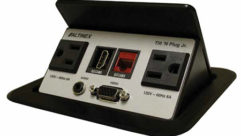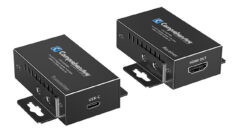THE LONG, STRANGE TRIP
Jun 1, 2001 12:00 PM,
Peter H. Putman, CTS
IT ALL STARTED INNOCENTLY ENOUGH in October 1999. I was testing a Princeton AF3.0HD direct-view monitor and decided to see if I could receive the local DTV broadcast of ABC’s Monday Night Football. As luck would have it, a Panasonic TU-DST50W DTV set-top box was available for a couple of weeks. Now, all I needed was an antenna.
But what kind of antenna? And where would I point it? Even though I knew which Philadelphia-area stations were broadcasting DTV signals, I didn’t know how much power any of them were running, or how many hours a day they were transmitting.
So, I did what most reasonable people would do when confronted with first-time reception of DTV signals. I bought the biggest UHF antenna I could find and a couple of hunks of RG-6 co-ax. Without the benefit of a signal strength meter (or any kind of meter, for that matter), I managed to pick up three local stations — KYW-26, WTXF-42, and WPVI-64 — by using a temporary mast and tripod and pointing the antenna towards the Philadelphia transmitter sites, 25 miles away over a nearby ridge.
While the signal from KYW was pretty steady, both the Fox and ABC channels suffered from frequent drop-out. A move to another location was in order, so the temporary mast and tripod support moved to the rear deck of my home, held in place with C-clamps and guy ropes. Reception improved a little bit: Now, I only had an occasional “hit” on channel 42 or 64. Close enough for government work!
Still, I wasn’t satisfied with this setup. The antenna seemed entirely too large for the reception distance I needed. There had to be a way to simplify the antenna system, make it smaller and less obtrusive, and perhaps even get it to work indoors.
Does this story sound familiar to you? In the past year, I have corresponded with many end-users, dealers and systems integrators who have come to grief with the reception of DTV signals, both indoors and out. In one local case, a complete home theater system worth several tens of thousands of dollars is still unable to receive even the strongest Philadelphia DTV broadcaster reliably while using an attic antenna.
OH, NOW I GET IT
What a difference a year-and-a-half makes. Now, I can plunk a small desktop antenna — the British-made Silver Sensor — on the workbench in my basement and watch several Philadelphia and Allentown DTV broadcasts with no drop-out. And that’s without a preamp of any kind. (See Figure 1.)
Now, to be fair, I should note that DTV receivers have gotten better since 1999. My newest set-top box, Samsung’s SIR-T150 terrestrial tuner, is at least 6 dB more sensitive than the first-generation set-top boxes I tested. It also handles signal multipath better, thanks to advancements in demodulator chips and other receiver components.
Still, the biggest improvement in my DTV reception was the result of rethinking how well antennas should work, particularly with the demanding, multipath-sensitive 8VSB signals used by the ATSC DTV system. (And I’m not going to get into the COFDM vs. 8VSB controversy. Suffice it to say that the FCC has spoken, and 8VSB is going to be the DTV modulation system in the USA, for better or worse.)
As a holder of an amateur radio license since high school (over 30 years ago), I spent much of my youth building and testing antennas: wire antennas, beams, quads, collinear arrays, phased arrays and even circular polarized antennas. I’d used them in stacked arrays to bounce signals on 432 MHz off the moon, and to scatter VHF and UHF signals along the troposphere.
If I learned one thing as a ham radio operator, it was this: The most cost-effective improvements to any transmitting or receiving system are always made to the antennas. It can be quite expensive to pick up 6 to 10 dB with a high-powered transmitter, particularly at UHF and microwave frequencies. A preamp will provide additional signal sensitivity, assuming it isn’t susceptible to overload. However, 6 to 10 dB of antenna improvement is quite an inexpensive proposition.
Regular readers will recall my three columns from last year, wherein I detailed my experiences with off-the-shelf DTV antennas. When I began the project, I had no idea how much the science of antenna design had strayed from the true path — the path of creating efficient antennas that worked well at specific frequencies, using lightweight but durable materials.
Instead, what I see now is a market dominated by “trick” antennas with unusual designs or gimmicky, active antenna elements. Many of these antennas were designed to satisfy an aesthetic requirement more than a performance need. Perhaps that reflects the market for TV antennas in an age where more than 70% of the homes in this country receive television via cable, and others depend on DSS and small satellite dishes.
BACK TO THE DRAWING BOARD
Even so, our new broadcast DTV system (not to be confused with digital cable) relies entirely on an over-the-air delivery mechanism. That means unless you have a cable system that is willing and able to carry DTV signals, you won’t be able to watch such fun HDTV programs as the Super Bowl, NCAA Final Four, the U.S. Open, numerous prime-time shows and movies, and Jay Leno’s nightly antics without hooking up a TV antenna to your set-top tuner.
The good news is that receiving DTV signals does not — I repeat, does not — require super-expensive antennas. Indeed, several costly, hipster antennas I tested didn’t perform all that well for DTV reception, particularly on UHF signals (where the majority of DTV allocations are now). My initial tests with an efficient UHF antenna design started with the simplest of all antennas, and one that had been developed long before regular television broadcasts.
That first prototype used a full-wave folded dipole, which many readers will recognize as a common TV antenna feature. The folded dipole is actually the driven element, the only active element of an antenna, and the only part connected to the feedline (coaxial cable). Folded dipoles are comparatively easy to match (their typical impedance is about 300 ohms) and don’t take up a lot of space.
Folded dipoles are also end-fed, balanced antennas, which means that the low-voltage point — or effectively, the ground of the antenna — lies at the center of the dipole. That makes it easy to mount the antenna through a boom support, provided the antenna is electrically insulated from the boom.
In contrast, a conventional dipole is fed in the center, which requires the dipole to be mounted clear of the boom, as well as electrically insulated from it. I’ve also found dipole antennas to be narrower in frequency response than folded dipoles — not a practical solution when trying to cover 300 MHz of spectrum.
So the first step of this strange journey was to bend some #6 electrical ground wire into a folded dipole configuration, using a 1-inch-diameter piece of PVC pipe. It was simple enough to calculate a full wavelength at the desired frequency (in this case, I aimed for 650 MHz, or halfway up the UHF band) and apply an appropriate velocity factor, or compensation for the effects of RF traveling on copper wire.
The formula for wavelength (in meters) is:
wavelength = 300/frequency
A typical velocity factor might be 0.85 to 0.9 of the calculated length.
A few minutes later, I had a good looking 8VSB waveform on several local DTV stations; and I achieved this with the antenna supported on my rear deck, surrounded by buildings and trees. Adding a simple reflector made from radiator screen and a couple of directors (passive elements in front of the driven element that add directivity to the antenna) resulted in about 6 dB more signal.
In short order, I connected a 75-ohm balun and ran 50 feet of Radio Shack RG-6 from this “plumber’s special” down through my basement window and into the rear of the Panasonic TU-DST50W tuner. Voila! I now had a steady picture on KYW-26, WTXF-42 and WPVI-64 for a total investment of about $10 in parts.
My exploits from that point forward are well-documented in my previous columns. The result was a pair of compact UHF antennas that are currently undergoing a patent search, so I can’t divulge all of the details yet. Suffice it to say that these antennas do work quite well. One was installed on my roof for a few weeks to pull in signals from as far as New York City, more than 64 miles away. Of course, I did use an accessory preamp (Channel Master’s Titan 2 #7775) to boost signal levels.
In the meantime, I began taking the pile of antennas I had accumulated — over a dozen models — and looking to see if I could make them work better. Most commercially made antennas are constructed from lightweight aluminum tubing and are largely crimped or riveted together, a manufacturing process not terribly conducive to experimentation.
After reviewing the candidates, I selected Channel Master’s 4308, a small suburban UHF yagi antenna. While this antenna does an adequate job of analog and digital UHF reception, it didn’t have enough gain above channel 40 for my needs. In the Philadelphia area, we have three DTV stations operating above channel 60, and this antenna wasn’t cutting the mustard for reliable DTV reception on any of the three.
So, after some tinkering and lots of paper calculations, I came up with a few modifications that turned this antenna into a much better performer. These mods can be done by anyone with an electric drill, a vise or pliers, tin snips or metal shears, a tape measure or ruler, and a standard tubing or pipe cutter. See the Sidebar, “Arts and Crafts Time.”
As I write this, the modified 4308 yagi is atop my roof, used in combination with the aforementioned Channel Master 7775 UHF preamp for reception of all five New York City DTV stations — and three of these aren’t at full power yet. I’ve also picked up DTV channel 41 from Wilkes-Barre, Pennsylvania; a distance of almost 70 air miles.
At least one reader of an HDTV forum where I posted this modification reported 80% to 90% reliable reception of a DTV station nearly 60 miles distant in South Carolina, using an RCA DTC-100 set-top box. Previously, he was unable to lock up a signal at all.
I’ve done other mods. Radio Shack’s 15-1862 amplified UHF/VHF indoor antenna underwent some cosmetic surgery to its active element with encouraging results. Indoor reception of DTV signals was more reliable and less susceptible to drop-out after the mod. The ability to rotate the driven element helps with multipath, too.
I plunked this modified antenna atop a front projector in my basement theater and used it to pull in ABC’s digital SDTV broadcast of the Orange Bowl. While doing so, I thought about just how far my tests had come since that first night when I stuck a big, long, deep fringe UHF yagi atop 10 feet of mast, out next to my garage, just to watch an intermittent DTV signal. Now, I didn’t even need to put up an outside antenna to watch the same station! (No, WPVI’s transmitter power hadn’t changed in the interim.)
The tests aren’t finished. I’m trying to see how small I can make an efficient UHF antenna for DTV reception, one that has good front-to-back ratio, a wide beamwidth and moderate gain. Some interesting antennas have resulted, including a super-small 6-inch design that mounts with a work light clamp. I’ve also been experimenting with longer UHF yagis to improve their performance.
To date, I’ve not paid any attention to VHF signal reception, and for a good reason: There are no VHF DTV stations broadcasting in my area (or, for that matter, in most major markets from Washington, D.C., to Boston). That doesn’t mean I’ve forgotten the VHF crowd. The nice thing about antenna designs is that they are scalable.
In short order, I will begin working on a high-VHF (channels 7 to 13) antenna design. The majority of the VHF DTV station allocations in the USA lie within this range, so there will be a need for efficient antennas to serve customers in these areas. That will be a tricky task because the lower you go in frequency, the larger the antenna must be to resonate.
If you are attending INFOCOMM in Las Vegas, I will once again be presenting a seminar on digital television, with an in-depth look at antennas and reception issues. Try to make it if you can. Who knows? Maybe it will be possible to put together a simple antenna for some indoor DTV reception at the Venetian Hotel, the ICIA conference site!
Peter H. Putman owns PHP Communications, Doylestown, Pennsylvania. He is the author of The Toastmasters Guide to Audio/Visual Presentations.
Arts and Crafts Time: Antenna Improvements
Got your tools out? Here are the steps to follow*:
- The CM 4308 is shipped assembled in one piece. The bowtie-shaped driven element needs to be swung into place. Do not attach the loose ends yet.
- Carefully swing open the reflector assembly, but do not swivel the reflector elements into place yet. Measure and mark the four reflector elements to a maximum length of 12 inches (6 inches each side of the center of the swivel mount). The use the tubing cutter to remove the excess tubing. You can flatten/crimp the ends of each tube as before if you are at all concerned about moisture build-up.
- Drill out the two rivets holding the reflector assembly to the 1-inch boom. Use your ruler or tape measure to find a spot 4 inches to the rear of the antenna terminal connections. (This measurement is not super critical; between 4 and 4.5 inches is okay.) Mark this spot on the boom.
- You will wind up sliding the reflector assembly forward towards the antenna terminal block. Position the reflector assembly so that the two rivet holes lie on either side of the 4-inch mark — one in front and one behind. Mark and drill two new holes on the same center line as the two old rivet holes. Use a pair of half-inch 6-32 machine bolts, lockwashers, and nuts to secure the reflector assembly in the new holes.
- Carefully straighten out the metal straps that attach to the antenna terminal block. You can flatten them with a vise or pliers. Wrap a piece of cloth around each strap to avoid dimpling or otherwise marring it as you bend/flatten it.
- There are two straps connected to the other side of the antenna terminals.These two straps run parallel to the antenna boom for a few inches. They are supported at the far end by a plastic insulator. Use the tin snips to cut both straps away from the antenna terminal block. Drill out the rivet holding the plastic insulator and remove it. Save the two straps!
- You will need to short together the two threaded machine bolts on the opposite side of the antenna terminal block. Cut one of the strips and drill out two small holes to fit over the bolts. Fnd an extra set of nuts (wing nuts are fine) to secure this shorting strap.
- Go back to the long straps you straightened out previously. Using a ruler, measure from the center of the boom 8 inches along each strap. Mark this point on each strap. The distance between the two marks should be 16 inches. Cut off any excess strap with tin snips. (If the UHF DTV stations in your area are primarily on channels below 50, make the total length of the strap 17 inches, 8.5 inches on either side.)
- Drill two holes to fit over the machine bolts attaching the antenna leads. These will be the same diameter as the holes used to attach the shorting bar in Step 7. Using a broomstick or other round object about 1 inch in diameter, carefully bend the 8-inch straps back on themselves, so that the holes you just drilled line up with the antenna lead terminals.Do not crease or bend the straps too much — they may break. You should be able to curl and attach the straps in one motion. A slight kink in the strap isn’t cause for alarm, so it’s okay if you don’t get a perfectly rounded bend.)
- Once you have the modified straps attached to the antenna terminals, use the supplied washers and wing nuts to attach the supplied balun (or 300-ohm twin lead). The finished antenna should look like the photo above.
The results? I was able to increase the signal strength from local channel 42 by 1.8 dB, channel 46 by 2 dB, channel 55 by 4 dB, and from local channel 64 by 5 dB. The waveforms I received were cleaner, too — I saw less multipath notching on the 8VSB waveforms.
*Note that this modification is not endorsed or recommended by Channel Master LLC. ROAM Consulting Inc. assumes no responsibility for any damage or malfunction that may happen to an end-user’s television or receiver from improper modification or use of this antenna, nor does ROAM Consulting Inc. make any guarantees about reception of analog or digital TV signals with this antenna.









